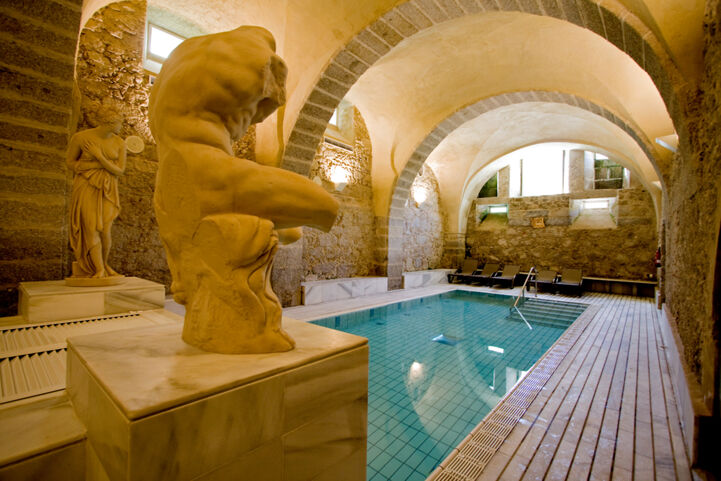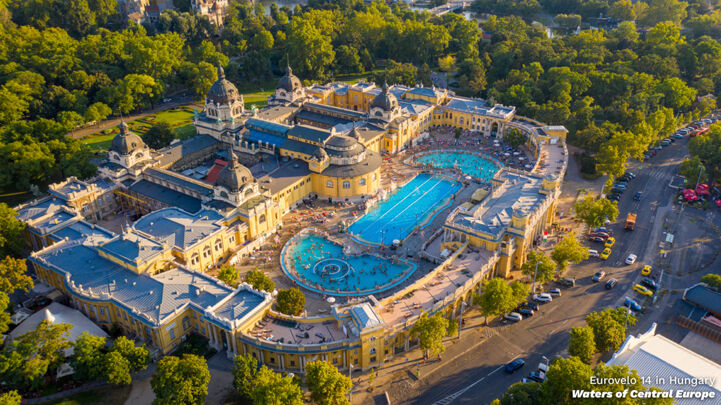The best thermal spa towns along EuroVelo routes
Thermal tourism, one of the earliest forms of modern tourism, has a rich history rooted in the belief in the healing powers of natural thermal springs. People were coming to thermal towns seeking wellness and health. Not much has changed since then: the tradition persists, with visitors still drawn to these destinations for their therapeutic benefits. Meanwhile, cycling is a popular pursuit of active tourism, where combining the two, it is a great way to feel good and give your body and mind a time off!
As travelers embark on their journeys along the EuroVelo routes, they have the opportunity to discover the thermal spa towns and a world of wellness, culture, and natural beauty.
Bath, United Kingdom (EuroVelo 2 - Capitals Route)

City of Bath is one of the Great Spa Towns of Europe, and has a rich history of using its thermal waters for health and wellness, dating back to pre-Roman times. Today, following EuroVelo 2 – Capitals Route, you can experience this ancient tradition, where you can soak in the same mineral-rich waters that have rejuvenated people for centuries.
Travellers can cycle through the green countryside surrounding the town before going for a relaxing experience in the natural thermal waters. Do not miss one of the world’s most iconic spa destinations, so unique that it has been listed as a UNESCO World Heritage Site, not once but twice!
Baños de Montemayor, Spain (EuroVelo 1 – Atlantic Coast Route)

Located in the charming town of Baños de Montemayor, the spa is a captivating stop along EuroVelo 1 – Atlantic Coast Route in Spain and an essential highlight on the historic Ruta de la Plata. With origins tracing back to the Roman era, visitors can enjoy both modern spa facilities and ancient Roman baths, offering a unique mix of old and new.
Surrounded by the beautiful Extremaduran countryside, Baños de Montemayor Spa offers a peaceful getaway where you will also have the chance to explore the region's history and enjoy local food
Karlovy Vary, Czechia (EuroVelo 4 - Central Europe Route)

Situated directly on EuroVelo 4 - Central Europe Route and near EuroVelo 13 – Iron Curtain Trail, Karlovy Vary is one of Czechia's most famous spa towns and one of the Great Spa Towns of Europe. The symbol of the town, the Mill Colonnade, with its numerous hot springs and 124 columns should not be missed! After a day of cycling, you can relax in one of the many thermal baths. As the city was founded in the 14th century by Charles IV, the Holy Roman Emperor, Karlovy Vary has a rich cultural heritage and beautiful architecture to explore. It is highly recommended for the film-lovers to visit during the annual International Film Festival.
Czechia is home to numerous historic thermal towns, making it an ideal destination for combining cycling with relaxation. Notably, there are two other Great Spa Towns — Mariánské Lázně, and Františkovy Lázně conveniently located near EuroVelo 13, providing a perfect opportunity for a unique cycling, heritage and wellness journey.
Baden bei Wien, Austria (EuroVelo 9 – Baltic-Adriatic Route)

Baden bei Wien, located on the EuroVelo 9 – Baltic-Adriatic Route, is a must-visit Great Spa Town southwest of Vienna. Known for its therapeutic thermal baths, it offers the perfect place to relax after a day of cycling. The town's charm is enhanced by its 19th-century Biedermeier architecture, the beautiful main square with the Trinity Column, the extensive Kurpark with trails leading to the Vienna Woods.
With bike-friendly accommodation and a rich cultural heritage, Baden bei Wien provides a unique blend of relaxation and exploration for cyclists. It is an essential destination for enthusiasts of Beethoven and Mozart: the town honours their legacy with memorials and concerts.
Budapest, Hungary (EuroVelo 6 - Atlantic - Black Sea and EuroVelo 14 - Waters of Central Europe)

At the crossroads of both EuroVelo 6 - Atlantic - Black Sea and EuroVelo 14 - Waters of Central Europe, Budapest is known for its unique and varied thermal baths, blending Eastern and Western traditions. Recognised as a "Spa City" since the 1930s, Budapest is the only capital city that's also a renowned spa centre. There are 123 natural hot springs, producing 70 million litres of thermal water daily. Must-visit baths include the famous Gellért Baths, Széchenyi Baths, and the authentic Turkish Rudas and Király Baths. For a unique and historical spa experience, Budapest is an unparalleled destination which is impossible to miss!
These spa towns offer more than just relaxation – they also provide a unique opportunity to explore Europe's stunning countryside and cities on two wheels. So why not hop on your bicycle, pedal along the EuroVelo routes, and discover the perfect blend of wellness and adventure? Download GPX tracks and find more information about each route. It's an experience you will not forget!
Great Spa Towns of Europe
The Great Spa Towns of Europe is a ‘Serial Transnational’ World Heritage Site, made up of 11 famous historic spa towns and cities in seven European countries. This incredible site was recognized internationally when it was inscribed on the UNESCO World Heritage List in 2021, so as to preserve it for humanity. The 'Great Spa Towns', which for centuries have been using water, exercise and cultural activities as an unbeatable recipe for wellness, can be found in Austria, Belgium, Czechia, France, Germany, Italy and the United Kingdom. Many of the towns have been connected to the European rail network since the earliest days of rail travel, which fits in well with the GSTE’s responsible tourism approach. The good news for cyclists is that all Great Spa Towns of Europe are located on or in the immediate vicinity (maximum 20 km away) of a EuroVelo cycle route, with the exception of Vichy at approx. 60 km from the nearest route.
European Route of Historic Thermal Towns
The European Route of Historic Thermal Towns is one of 38 thematic Cultural Routes of the Council of Europe, also including the EuroVelo 13 - Iron Curtain Trail. The Route brings together 50 member towns across 18 European countries, and functions as a grassroots network to promote and preserve towns and territories with a rich historical and cultural heritage in using their thermal waters for health and wellbeing.
Article by Sofiia Osovska, with kind contribution by Catherine Lloyd